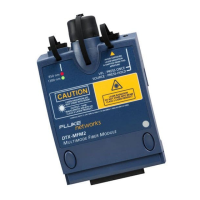DTX Series CableAnalyzer
Technical Reference Handbook
11-2
3
On the Custom screen, select Name; then use the text
editing screen to enter a name for your custom cable
type. Press
N when you are done.
4
On the Custom screen, select Use Default Values From,
select a cable group; then select a cable type as a
baseline for your custom cable type.
5
To change the NVP for your custom cable, select NVP
on the Custom screen. You may set the NVP to a
specified value, or determine the actual NVP of a
sample of cable. See "Changing the NVP" on page
11-7.
6
From the Custom screen, press N when you are done
creating the cable type.
The tester saves the custom cable type in the Custom list,
with asterisks (*) before and after the name.
Creating a Custom Twisted Pair Test Limit
You can create up to nine custom twisted pair test limits. A
custom twisted pair test limit includes the following
settings:
•
Custom limit name
•
Baseline limit for default settings
•
Maximum length
•
Resistance test enabled or disabled
•
Insertion loss test enabled or disabled
•
NEXT test enabled or disabled
•
PSNEXT test enabled or disabled
•
ELFEXT test enabled or disabled
•
PSELFEXT test enabled or disabled
•
ACR test enabled or disabled
•
PSACR test enabled or disabled
•
Return loss test enabled or disabled

